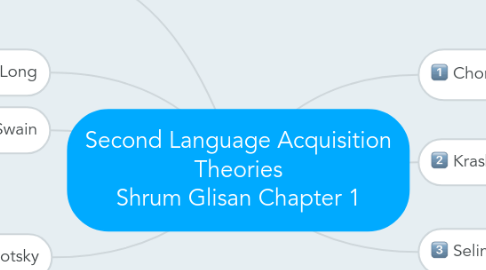
1. Long
1.1. Comprehensible in 3 ways
1.1.1. simplify input
1.1.2. Modify interactional structure of the convo.
1.1.3. use linguistic and extralinguistic features
1.2. Negotiate meaning with each other: navigate a communication breakdown and work toward mutual comprehension.
2. Swain
2.1. Learners need opportunities to produce output
2.1.1. To do so: Need purposeful, meaningful, motivational and age appropriate tasks
2.1.2. Why?
2.1.2.1. helps learners see the gap between what they can say and what they want to say.
2.1.2.2. develop automaticity and move from analysis to ease in response
2.1.2.3. provide opportunity to try rules and modify them
2.1.2.4. reflect on abilities and knowledge in TL
3. Vygotsky
3.1. Self-talk
3.1.1. private speech to help one navigate a task, particularly when difficult
3.1.2. Mental rehearsal: silent repetition, mental practice, taking notes
3.1.3. Lantolf: Language play: imitate and transform what others say
3.1.4. Ludic Play: play with language form, sounds, rhyme, rhythm song, play with meaning, combining semantic elements to create words that do not exist.
3.2. Zone of Proximal Development
3.2.1. Mediation within the ZPD
3.2.1.1. Tools: textbook, visuals, classroom discourse patterns, opportunities for interaction in the TL, direct instruction or teacher assistance, Portfolio
3.2.1.2. result of the social and school learning practices for what is used
3.2.2. Scaffolding
3.2.2.1. enlist interest, simplify task, keep learner motivated and on task, highlight important features, reduce stress and frustration, model idealized form of act.
3.2.2.2. Know when to turn task over to novice for solo performance
3.2.3. language performance with others exceeds what one could do alone
4. Motivation
4.1. Motivation of Individual Learners
4.1.1. Gardner 1985
4.1.1.1. Instrumental
4.1.1.2. Integrative
4.1.2. Dörnyei (1994)
4.1.2.1. Course specific factors
4.1.2.2. Group specific factors
4.1.2.3. Teacher specific factors
4.1.3. Oxford and Shearin 1994
4.1.3.1. personal beliefs of success/failure
4.1.3.2. self-reward/evaluate
4.1.3.3. instructional features of the course
4.1.3.4. assistance to learner
4.1.3.5. feedback
4.1.3.6. Relevance
4.2. Motivation within tasks
4.2.1. meaningful result=more effort
4.3. TEACHERS CAN
4.3.1. ID why learners are studying TL
4.3.2. provide positive classroom atmosphere to keep anxiety down
4.3.3. encourage leaners to set their own goals and intrinsic rewards system
4.3.4. help shape beliefs of success and failure
4.3.5. illustrate rewards of TL
5. Chomsky
5.1. Communicative Competence
5.2. Sociocultural Competence
5.3. Discourse Competence
5.4. Actional Competence
5.5. Linguistic Competence
5.6. Strategic Competence
6. Krashen
6.1. Acquistion-learning Hypothesis
6.1.1. Acquisition model: picking it up, like children do
6.1.2. Learning: Conscious effort to know and apply rules
6.2. The monitor hypothesis
6.3. Natural order hypothesis
6.4. Input hypothesis
6.5. Affective Filter hypothesis
6.6. Binding
7. Selinker
7.1. U shaped behavior
7.2. Interlanguage theory
7.2.1. interference of the L1
7.2.2. effect of instruction
7.2.3. overgeneralized rules
7.2.4. strategies in L2 learning
7.2.5. strategies for L2 communication.
